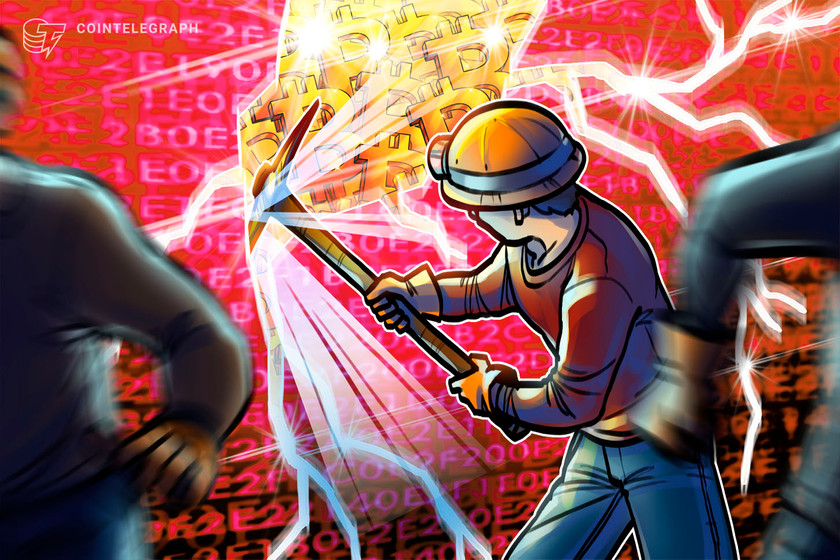Nifty News: BTC miners cash $5M on Ordinals, Reddit NFTs get botting backlash and more


Bitcoin transaction fees from Ordinals inscriptions have exploded by 240% over the last month.
Bitcoin (BTC) miners have pocketed over $5 million from creating nonfungible tokens (NFT) inscriptions using the Ordinals protocol.
Transaction fees for Ordinals transactions exploded 240% from $1.5 million on March 10 to 5.2 million by April 12, according to Dune Analytics data.
The rise came on the back of a relatively slow period between Feb. 16 and March 10, from $1 million to $1.5 million. Before that, fees hit the $1 million mark within the first four weeks of the Ordinals protocol launching on Jan 21.


Nearly 1.1 million Ordinals have been inscribed on the Bitcoin network, mostly comprising JPEG images and text but also consisting of PDFs, video and audio formats.
Roughly 100 to 500 inscriptions are processed in each Bitcoin block, which usually contains between 2,000 and 3,000 transactions. Block 783,758 on April 3 saw a record 3,785 inscriptions, representing nearly 87% of the entire block.
This is Bitcoin block 783,758.
It currently holds the record for having the most inscriptions.
3,785 inscriptions to be exact.
That's 86.7% of its transactions.
Ordinals are quite literally on their way to becoming the number one use case on Bitcoin. pic.twitter.com/BxcfbcBWeM
— Leonidas.og (@LeonidasNFT) April 12, 2023
Reddit’s Gen 3 NFTs plagued by botting claims
Online community platform Reddit launched its third batch (Gen 3) of NFTs on April 12 — a “Futures Realities Collection” of collectible avatars created by over 100 artists.
Reddit explained in its announcement that the artists behind each limited edition Avatar will receive royalties upon each sale, and no cryptocurrency was needed to purchase them.
#RedditCollectibles fans, the wait is over! Gen 3 is officially available with limited-edition designs from over 100 different artists. Jump into the next dimension and get yours now. pic.twitter.com/QcCSAUs8rE
— Reddit (@Reddit) April 11, 2023
However, the release didn’t come without issues. Many Reddit users claimed they missed out on the sale because spam bots swooped in almost instantly.
Many also believe the bots were the reason behind Reddit’s NFT shop crashing shortly after launch.
“They didn’t incorporate any type of spam or bot prevention, like a simple captcha. Of course the site got overloaded,” one user wrote, with another remarking there was “no way you guys didn’t even think of stopping bots during this drop.“
Twitter user “Pastel Alpha” tweeted they managed to get “a good amount” of the NFTs “even though the site completely died” and thanked its “bot partners” for helping with its haul.
Even though the site completely died we managed to hit a good amount before the hour thanks to our custom Reddit monitor by our member @CheekyZoot
No need to guess links
Checkouts thanks to our bot partners @orcarobot and @MinTechBots
Pastel on top pic.twitter.com/vVd45om8ZW
— Pastel Alpha (@PastelAlpha) April 11, 2023
Reddit previously released a batch of Halloween-themed avatars in October 2022, which was followed by super bowl avatars in February.
Adidas releases first in series of dynamic NFTs
Shoe brand Adidas has released the first leg of its latest dynamic NFT collection, “ALTs by Adidas,” the latest move by the company in its quest to expand its NFT ecosystem.
The dynamic NFTs will evolve based on the decisions and engagement of the owner, according to an announcement on April 11, which described the collection as the “first step” toward owning an “ALTS by Adidas” identity.
Chapter 1: ALT[er] Ego starts now
This is your first step on your journey towards your own ‘ALTS by adidas’ identity.
At the end of Chapter 3 you will get a unique PFP consisting of countless trait combinations with a rarity rank.
ALTS by adidas is a dynamic NFT… pic.twitter.com/0D9lrvIy6y
— Indigo Herz (@indigo_herz) April 11, 2023
The floor price of each Adidas NFT is 0.666 Ether (ETH) ($1,275) and has raked in 351 ETH ($672,000) in trading volume so far. There are now 8,989 owners, 56% of them unique.
Related: NFT warranties can help mass adoption of the technology, says Web3 exec
There are 16,000 items in total, and the creators take a 10% cut of each sale.


Collectors must buy and burn phases 1 and 2 of Adidas’ “Into the Metaverse” tokens to receive the ALTS by Adidas NFT.
Be nonfungible, my friend: Bruce Lee enters Web3
An NFT collection commemorating the late kung-fu fighter and movie star Bruce “Little Dragon” Lee has been released by the Bruce Lee Estate in partnership with Shibuya, an NFT-driven video platform.
Plans for the release were revealed on April 11 when Lee’s Twitter account, managed by his family, shared an old video clip of Lee, transforming him into an animated version of himself.
My last name is Lee. Bruce Lee. pic.twitter.com/hc678dzRgO
— Bruce Lee (@brucelee) April 11, 2023
The NFTs sold at a starting price of 0.008 ETH ($15), with 13,907 minted in the first 24 hours, totaling over $205,000, according to its smart contract address on Etherscan.
The NFTs were drawn by artist Emily “pplpleasr” Yang and were designed by Shannon Lee — Bruce Lee’s daughter.


Despite it being an “open edition” collection, collectors can only mint a maximum of 100 of the NFTs.
Other Nifty News
NFT marketplace OpenSea launched “OpenSea Pro” last week, a new, specialized NFT marketplace aggregator aimed at serving the needs of professional NFT traders. The service was made possible by OpenSea’s acquisition of fellow NFT aggregator Gem in April 2022.
An NFT trader “fat-fingered” a bid for a free NFT, buying it at 100 Ether ($191,000). The token was part of NFT marketplace OpenSea’s Gemesis NFT collection to commemorate the launch of OpenSea Pro on April 4. Some believe the trader meant to bid the token for $100 instead.
NFT Creator, Emily Xie: Creating ‘organic’ generative art from robotic algorithms
















